Captain Cook Snorkel Tour The Ultimate Guide
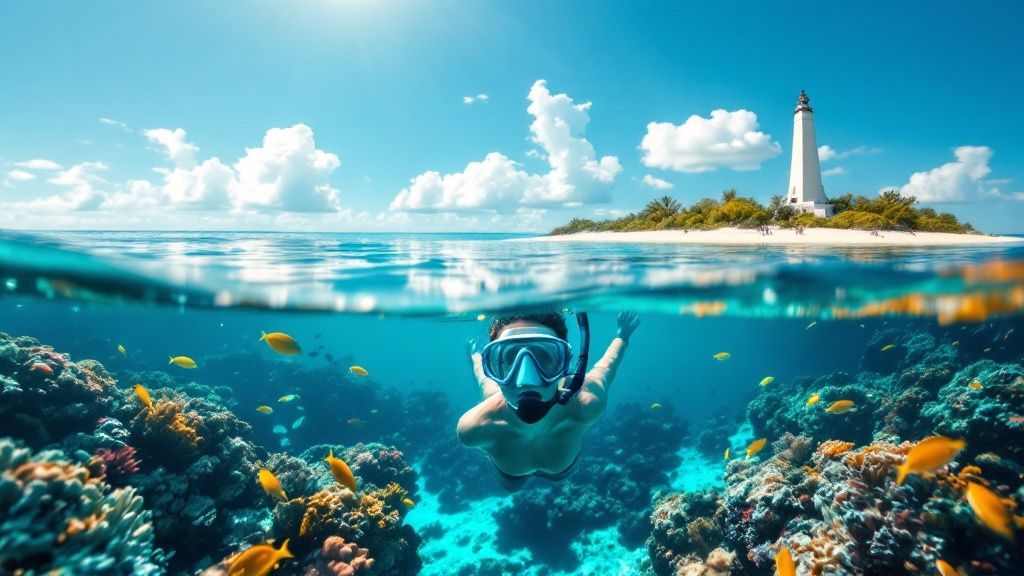
Picture this: you're floating weightlessly in calm, turquoise water. All around you are brilliant coral gardens and shimmering schools of tropical fish, all set against a backdrop of rich Hawaiian history. This is what the Captain Cook snorkel tour is all about. It’s one of the Big Island’s most iconic adventures, combining world-class snorkeling with a trip into a protected marine sanctuary that also happens to be a major historical site.
This isn't just another boat trip—it's a full-on immersion into the pristine waters of Kealakekua Bay.
Why This Snorkel Tour Is a Must-Do Adventure
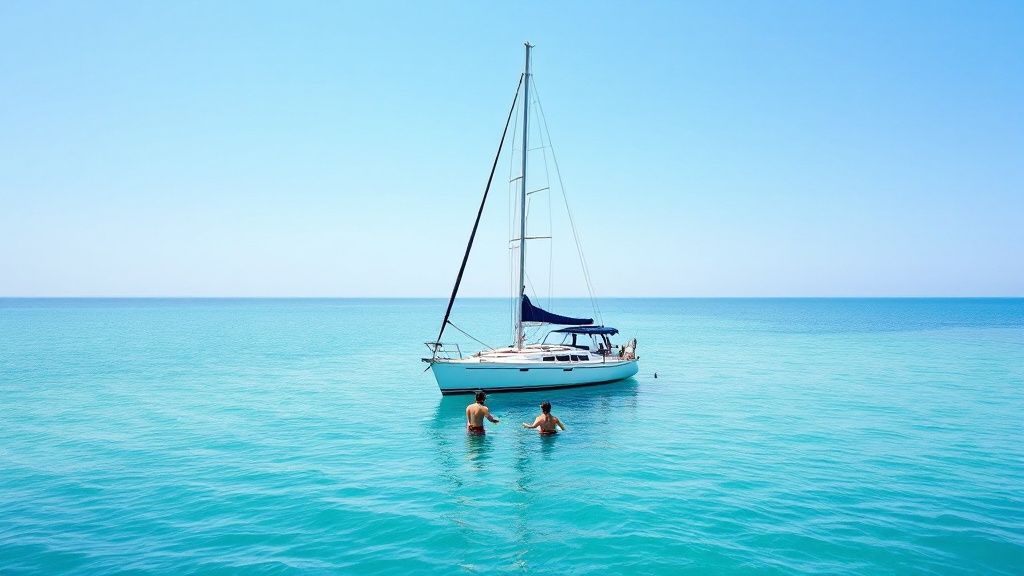
What makes the Captain Cook snorkel tour so special is that it really delivers two incredible experiences in one trip. First, you get the mind-blowing underwater scenery of Kealakekua Bay. Then, you get a living history lesson at the very spot where Captain James Cook first arrived—and later met his end.
Think of it as visiting a spectacular natural museum. The exhibits are living coral reefs, and the gallery walls hold stories of ancient Hawaiian culture and dramatic European exploration. That unique blend is what really sets it apart from any other snorkel trip on the Big Island.
The Magic of a Protected Sanctuary
The real star of the show is Kealakekua Bay itself. As a protected Marine Life Conservation District, the water here is stunningly clear, and it’s not uncommon for visibility to push past 100 feet. This protection has allowed the marine life to absolutely thrive, creating a bustling underwater city that feels completely untouched.
That special designation is the secret sauce. It means:
- No Fishing: The fish populations are huge and not shy at all, which means you get incredible up-close encounters.
- Healthy Corals: The reef is vibrant and healthy, supporting an amazing diversity of sea creatures.
- Calm Waters: The bay's natural geography shields it from the big ocean swells, making it a calm, safe playground perfect for snorkelers of all skill levels.
A Journey into Hawaiian History
Beyond the reef, the bay is steeped in cultural and historical importance. This place is hugely significant in Hawaiian history, forever tied to the arrival of Captain James Cook in 1779. Seeing that stark white monument on the shoreline—a landmark you can really only get to by water—connects you directly to that pivotal moment.
The powerful draw of this spot is clear. Kealakekua Bay brings in over 190,000 visitors a year, with its history being a massive pull. It's estimated that about 70% of tour-goers are just as fascinated by the Captain Cook history as they are the snorkeling. The other 30% are there purely for the world-class underwater experience inside the 315-acre protected district. You can get more insights on the bay’s unique appeal from the pros at Kona Hunu Divers.
This tour isn’t just about what you see; it’s about where you are. You're snorkeling in the footsteps of history, in a place that changed the Hawaiian Islands forever.
A Captain Cook snorkel tour truly offers a deep connection to both nature and the past. This guide will walk you through everything you need to know, making sure you’re ready for an adventure you won't soon forget.
Choosing the Right Tour for Your Crew
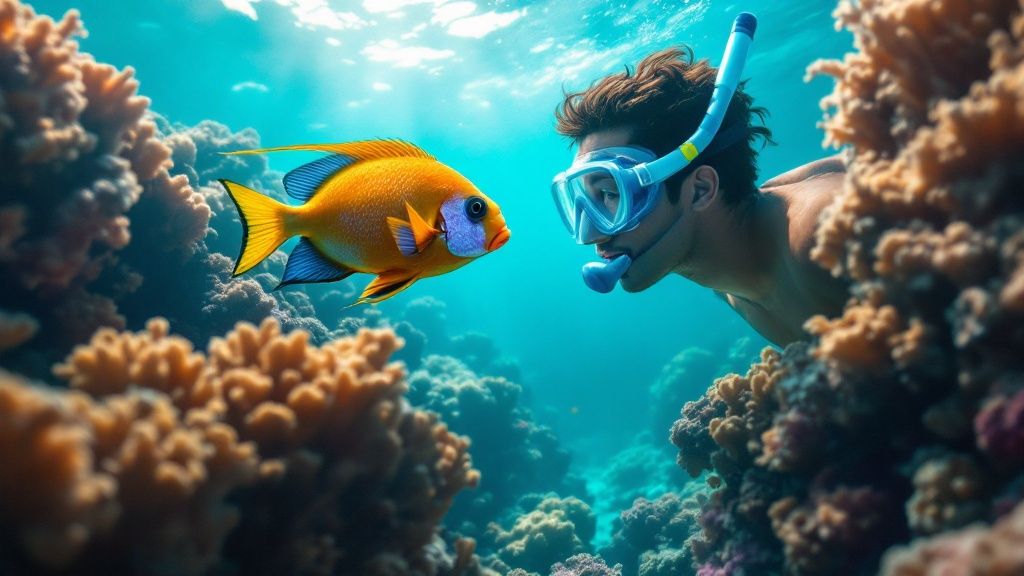
Picking the perfect Captain Cook snorkel tour is a lot like choosing a hotel. Are you after a quiet, boutique experience with personal touches, or are you looking for an all-inclusive resort buzzing with energy? The "right" tour really comes down to matching the boat's vibe with your group's personality.
The operator you choose genuinely shapes your entire day. It sets the group size, the pace of the adventure, and what amenities you'll have on board. One style isn't better than another; they just cater to different kinds of travelers.
Thrill Seekers and Adventurers
If you want to get to the snorkel spot fast and feel the ocean spray on your face, a zodiac-style raft is your best bet. These are smaller, more nimble boats that offer a bare-bones, high-adventure experience. Think of it as an express shuttle to the underwater world.
- The Vibe: It's exhilarating and intimate. The focus is purely on maximizing your time in the water.
- Best For: Solo travelers, adventurous couples, and small groups who care more about the snorkeling than the onboard bells and whistles.
- What's Included: You'll get high-quality snorkel gear and a knowledgeable guide. Amenities are minimal, so packing your own snacks and drinks is a good idea.
As a bonus, these zippy boats can often duck into sea caves and explore lava tubes along the coast if conditions are right, adding an extra layer of discovery to the trip.
Families and Comfort-Focused Cruisers
For those traveling with a mixed-age group or who simply prefer a smoother, more stable ride, a mid-sized catamaran is the way to go. These boats strike a perfect balance between comfort and adventure, which is why they're such a popular choice.
Choosing the right tour is less about the destination—everyone goes to the spectacular Kealakekua Bay—and more about the journey you take to get there. The boat you pick sets the tone for your entire adventure.
When you have little ones in tow, comfort is king. Catamarans are great for this, often featuring onboard restrooms, plenty of shade, and easy-to-use ladders for getting in and out of the water. For more tips on making the day go smoothly, an ultimate guide to traveling with young children can be a lifesaver.
Social Butterflies and All-Inclusive Fans
If you believe the journey is just as important as the destination, then a larger boat with all the extras is for you. These tours are designed to be a full-blown social event where everything is taken care of.
- The Vibe: Lively and fun, almost like a party on the water. These boats are floating platforms for a good time, often decked out with music, waterslides, and a bar.
- Best For: Big groups, families with teens, and anyone looking for a full-day, all-inclusive experience.
- What's Included: These trips often come with a full lunch buffet, snacks, an open bar (after you’re done snorkeling, of course), and fun toys like slides and paddleboards.
Captain Cook Snorkel Tour Operator Comparison
To make it easier to see how these options stack up, here’s a quick breakdown. This table compares the different styles of tours so you can find the perfect fit for your crew.
| Tour Type | Typical Group Size | Average Duration | Price Range (Per Person) | Best For |
|---|---|---|---|---|
| Zodiac-Style Raft | 6-12 people | 4 hours | $120 – $180 | Adventurers & small groups focused on snorkeling. |
| Mid-Sized Catamaran | 20-40 guests | 5 hours | $150 – $220 | Families, mixed groups, and comfort seekers. |
| Large Vessel | 40+ guests | 5+ hours | $160 – $250 | Social groups wanting an all-inclusive party vibe. |
| Private Charter | Your group only | Varies | $500+ | Those wanting a completely customized experience. |
At the end of the day, whether you choose a zippy raft or a spacious catamaran, you're heading to the same incredible spot. The goal is just to pick the ride that will make your day perfect. Understanding these differences is the first step, and our comprehensive guide on the Kealakekua Bay & Captain Cook Monument snorkel tour has even more details to help you nail down your choice.
Discover the Underwater World of Kealakekua Bay
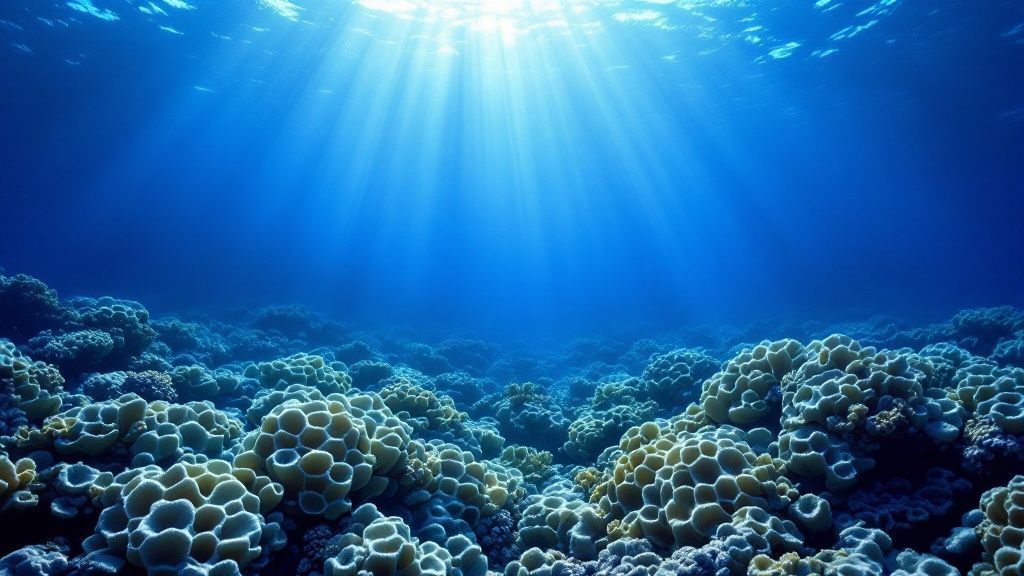
Slipping into the water on your captain cook snorkel tour is like being gently lowered into a completely different universe. Because Kealakekua Bay is a protected Marine Life Conservation District, it acts as a bustling underwater metropolis, and you can feel that vibrant energy the second your mask dips below the surface.
The water clarity here is legendary. On a good day, it honestly feels like you're flying over a submerged landscape. One minute you might be engulfed in a shimmering cloud of thousands of yellow tang, and the next you’re watching a pod of spinner dolphins putting on a distant acrobatic show.
The bay’s protected status is the secret sauce. It's allowed the coral reef system to stay incredibly healthy and vibrant, which is the foundation for everything you’re about to see. This isn't just about looking at fish through a window; you're a quiet visitor in their world.
What You Might See Beneath the Waves
Every single trip into the bay is different—that's part of the magic. The cast of characters you're likely to meet, however, is consistently incredible. This protected area is a true sanctuary for some of Hawaii’s most iconic and beloved marine life, offering encounters that stick with you long after you've dried off.
Your snorkel adventure is a front-row seat to an entire ecosystem in action.
- Honu (Hawaiian Green Sea Turtles): Seeing one of these ancient, graceful creatures is always a highlight. You’ll often spot them gliding effortlessly over the reef or resting peacefully on the sandy bottom. They are a deeply revered sight in Hawaiian culture.
- Spinner Dolphins (Naiʻa): The bay serves as a crucial resting area for these energetic marine mammals. You will almost always see them from the boat, and watching their pods from a respectful distance is an experience you’ll never forget.
- Colorful Reef Fish: Prepare for a visual overload. We’re talking about massive schools of brilliant yellow tangs, parrotfish (uhu) audibly crunching on coral, delicate butterflyfish moving in pairs, and of course, Hawaii’s state fish, the famously named humuhumunukunukuāpuaʻa.
This explosion of life is no accident. The health of Kealakekua Bay is completely dependent on all of us being respectful observers. Following simple guidelines ensures this underwater paradise stays this way for future generations.
This means your time in the water is more than just a swim; it’s an active participation in conservation. By choosing a responsible tour and following the rules, you help preserve this special place.
The Reef: An Underwater City
Think of the coral reef as the high-rise buildings and neighborhoods of this underwater city. Just like a city, it has its busy downtown areas, quiet residential streets, and even cleaning stations where bigger fish line up to have smaller fish and shrimp clean them of parasites.
Some of the key "residents" and their roles include:
- Parrotfish (Uhu): These are the reef’s gardeners. They use their beak-like mouths to scrape algae off the coral, which keeps the reef healthy and clean. They’re also responsible for creating much of the beautiful white sand you see.
- Surgeonfish (like Yellow Tangs): Often seen in large schools, these fish are the grazers. They mow down algae, preventing it from overgrowing and smothering the coral. Their bright colors make them one of the most visible species.
- Wrasses: These fish are the "doctors" of the reef. Many species of wrasse operate cleaning stations, a behavior that is fascinating to watch.
Understanding these roles transforms your snorkeling experience from simply seeing fish to understanding the intricate web of life that makes Kealakekua Bay so special. For a deeper dive into what makes this location a top snorkeling destination, our guide on the Kealakekua Bay snorkeling tour provides even more detail on this incredible ecosystem.
A Sanctuary Worth Protecting
Your tour crew knows better than anyone how to enjoy the wildlife without causing any stress. They'll guide you on the best practices for respectful observation.
It’s simple stuff, really: maintain a safe distance, never touch the coral or the animals, and only use reef-safe sunscreen. Following these easy guidelines helps ensure this underwater paradise remains pristine, so others can have that same jaw-dropping moment you're about to have. Your participation in a captain cook snorkel tour makes you a temporary guardian of this precious resource.
Explore the Rich History of the Bay
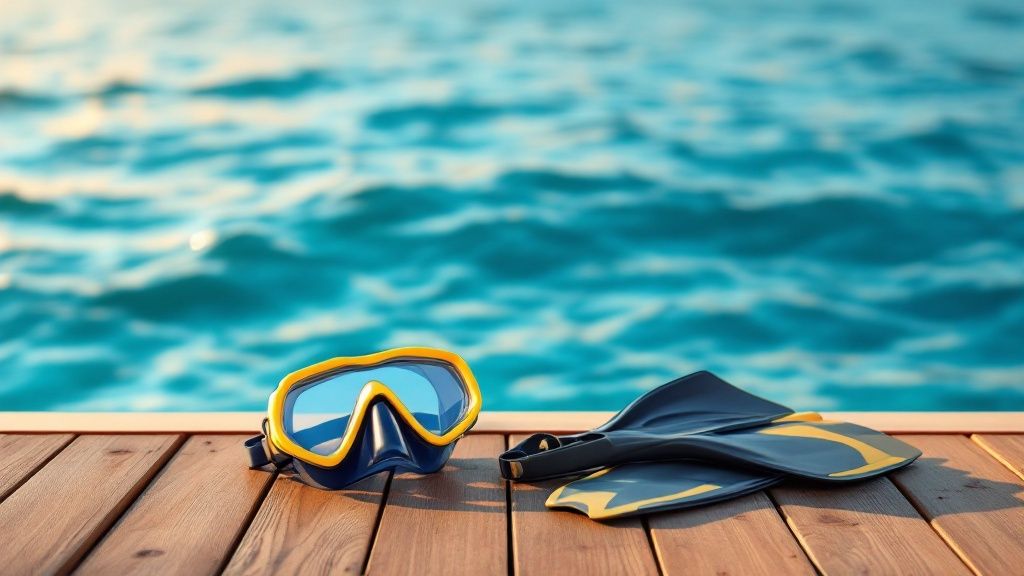
When you take a Captain Cook snorkel tour, you're doing a lot more than just going for a boat ride. As you glide into the calm, protected waters of Kealakekua Bay, you’re floating right over a spot that completely changed the course of Hawaiian history. This is ground zero for the first major, lasting contact between Western and Hawaiian cultures.
The best tour guides don't just point out the fish; they’re storytellers. They'll share the incredible story of Captain James Cook's arrival in 1779, not just from the European perspective, but from the deeply significant Hawaiian point of view. Hearing both sides of the story is what makes you truly appreciate where you are.
A Fateful and Uncanny Arrival
Captain Cook’s timing was, to say the least, uncanny. He sailed into Kealakekua Bay smack in the middle of the Makahiki festival, a sacred, months-long season celebrating Lono, the Hawaiian god of peace, agriculture, and fertility. During Makahiki, all war was forbidden—the islands were in full-on celebration mode.
Then, Cook’s huge ships appeared, with their tall masts and massive white sails that looked a lot like symbols associated with Lono. Because of this, many Hawaiians first welcomed him as a god. The arrival was peaceful and he and his crew were treated with honor, given provisions, and shown great respect. That goodwill, however, didn't last long.
A great Captain Cook snorkel tour approaches this complex history with the respect it deserves. The real magic is in the storytelling, which transforms your swim from a fun activity into a deep connection with the island's soul, honoring the past by embracing all its complexities.
The Conflict and the Monument
Things took a turn when Cook had to return to the bay for repairs after a ship's mast broke in a storm. By then, the Makahiki season was over, and when a cutter boat was stolen, tensions shot through the roof. Cook tried to take a high chief hostage to get the boat back, leading to a violent clash on the shoreline where he was killed on February 14, 1779.
While you're snorkeling, you can't miss the stark white obelisk on the shore—the Captain Cook Monument. It’s an iconic landmark sitting on a small piece of land that was deeded to the United Kingdom, marking the exact spot where Cook died. It’s a quiet but powerful reminder of the history that unfolded right where you're swimming.
Why a Boat Tour Is Essential
Just getting to this spot is an adventure. The monument is tucked away on a part of the coastline that’s incredibly hard to reach from land.
You really only have a few options:
- A serious hike: The Kaʻawaloa Trail is a tough 3.7-mile round trip with over 1,200 feet of elevation change on some really rough terrain.
- Kayaking: You’ll need a permit for this, and the paddle across the bay can be a real workout.
- A boat tour: This is, by far, the easiest and most enjoyable way to get there. The boat drops you right in the prime snorkeling area in front of the monument, no sweat required.
A Captain Cook snorkel tour isn't just the easy way in; it's the best way. It combines hassle-free access with the kind of expert stories and context that really bring the bay's powerful history to life.
How to Prepare for Your Snorkel Adventure
A little bit of prep work can be the difference between a good day and a truly epic one. When you pack smart for your Captain Cook snorkel tour, you can leave any worries behind on the shore and just soak in the incredible underwater world waiting for you at Kealakekua Bay.
Think of it like getting your daypack ready for a great hike; having the right stuff with you means you’re comfortable, safe, and ready for whatever the adventure brings. Most tour companies have the big gear covered, but a few personal items can really make the day.
What to Pack in Your Day Bag
Your tour will supply the essentials like masks, snorkels, and fins. But tossing these few extras in your bag will take your experience from just "good" to "unforgettable."
- Reef-Safe Sunscreen: This one is a must. Regular sunscreens have chemicals like oxybenzone that are seriously harmful to our coral reefs. Look for a mineral-based one with zinc oxide or titanium dioxide—it protects your skin and the fragile ecosystem you’re there to admire.
- Towels and a Dry Bag: You'll be so glad you brought a fluffy towel when you get out of the water. A dry bag is also a game-changer for keeping your phone, wallet, and a spare shirt bone dry, no matter how much splashing happens on the boat.
- Waterproof Camera: You’re about to see some amazing things down there. A GoPro or a similar underwater camera is perfect for capturing the shimmering schools of fish or a sea turtle gliding gracefully past.
Mastering Your Snorkel Gear
If this is your first time snorkeling, don't sweat it. The gear is pretty straightforward, and a couple of quick tips will have you breathing easy in no time. The single most important piece of gear? Your mask.
Getting a good seal is everything. Before you even put the strap on, just press the mask to your face and breathe in gently through your nose. If it suctions on for a few seconds, you’ve got a perfect fit. This simple trick is the key to preventing leaks and keeping your view of the reef crystal clear. For a deeper dive into getting comfortable with your setup, check out our complete guide on essential gear for snorkeling on the Big Island, Hawaii.
"The difference between a frustrating snorkel and a magical one often comes down to a well-fitting mask and relaxed breathing. Take a moment to get comfortable before you even leave the boat; it pays off."
Staying Safe and Comfortable on the Water
Your guides are total pros when it comes to safety, but how you prepare plays a big part, too. If you know you're prone to seasickness, maybe pop some motion sickness medicine about an hour before the tour. Staying hydrated and keeping your eyes on the horizon during the boat ride also helps a ton.
On these tours, protecting the environment is just as important as keeping guests safe. Tour operators have developed best practices over 30 years, like timing trips with the tides and sunlight for the best conditions. This is a big reason morning tours are so popular—the sea is usually at its calmest and the water is incredibly clear.
This commitment also means educating everyone on why the bay's 315-acre protected status is so vital for preserving the very reefs you're about to explore. When you come prepared, you can just kick back, relax, and fully immerse yourself in a world-class adventure with total peace of mind.
Got Questions About the Captain Cook Snorkel Tour? We've Got Answers.
Even with the best-laid plans, a few questions always seem to pop up right before a trip. We get it. You want to make sure you have all the details ironed out so you can just relax and enjoy the day.
Think of this as your final pre-tour briefing. We've rounded up the most common questions we hear from guests to clear up any last-minute uncertainties. Let's dive in.
When Is the Best Time of Year to Go?
Honestly, the snorkeling in Kealakekua Bay is fantastic any time you visit, but the seasons do offer slightly different experiences.
If you're chasing that picture-perfect, glass-like water with maximum visibility, aim for April through September. The weather is consistently beautiful, and the ocean is typically at its calmest. It’s prime snorkeling season.
But if you visit during the winter months, from December to March, you might get a massive bonus. This is humpback whale season, and spotting these gentle giants breaching on the boat ride over is a real possibility and an unforgettable sight.
Do I Need to Be an Expert Swimmer?
Not at all! You just need to be comfortable getting in the water. That's it. Every solid tour operator will provide top-notch flotation gear, like life vests or pool noodles. These do all the work, letting you float effortlessly while you soak in the views below.
Plus, the guides are always in the water with you, keeping a close eye on everyone and ready to help out. This makes the whole experience super safe and welcoming, even if you're a total beginner or just not the strongest swimmer.
The key is just to relax and trust your gear. The flotation devices are designed to keep you on the surface, so you can put all your focus on the incredible coral gardens and fish, not on treading water.
Can I See the Monument Without a Tour?
Technically, yes, but it’s a serious undertaking and not something we’d recommend for most people. Hopping on a boat tour is, without a doubt, the safest, easiest, and most pleasant way to experience both the monument and the phenomenal snorkeling.
The other options are pretty intense:
- Hiking: You'd be looking at a tough 3.7-mile round-trip hike on the Kaʻawaloa Trail. It’s not a casual stroll—it involves a steep 1,200-foot climb back up over very rough, sun-exposed lava rock.
- Kayaking: You can paddle across the bay, but you'll need to jump through some hoops to get a permit and rent from a licensed company. It's a serious workout.
What Should I Do If I See Turtles or Dolphins?
Seeing marine life in its natural habitat is the highlight of the trip, and it’s on all of us to be respectful guests in their home. The rules are pretty simple and are in place to protect these amazing animals.
By federal law, you need to stay at least 50 yards away from spinner dolphins and give Hawaiian green sea turtles (honu) a minimum of 10 feet of space.
The golden rule is simply to be a passive observer. Never chase, touch, feed, or try to ride any marine life. Let them be in control of the interaction. Your guides will give you a clear briefing on this so everyone—you and the wildlife—has a safe and positive experience.
Ready to experience one of the best snorkel spots in Hawaii? Kona Snorkel Trips runs top-rated, guided tours that put your safety, fun, and respect for the ocean first. Book your Captain Cook snorkel adventure today and get ready to make some incredible memories.
